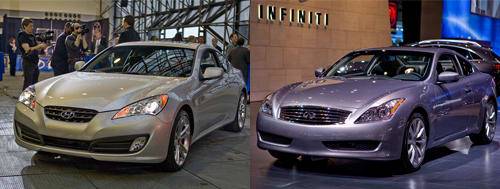Hyundai Genesis Coupe Takes on Infiniti G37


Hyundai is charging relentlessly into new territories with its products. Witness the Veracruz, a three-row SUV that Hyundai regularly compares to the Lexus RX 350 (which, if a recent Motor Trend comparison is any indication, might not be such a wild notion). Earlier this year, the automaker said it set sedans like the BMW 5 Series and Mercedes-Benz E-Class as the benchmark for its new Genesis sedan, and now press materials for the 306-hp, V-6 Genesis coupe — rumored to be priced starting under $26,000 — tout the $35,000-plus Infiniti G37 as a possible competitor.
The comparison Hyundai made concerned performance capabilities, so we’ll have to wait until we drive one before we can deliver a final verdict. That doesn’t mean we can’t have a little fun, though; at last week’s New York auto show, I checked out the two cars back to back.
Styling
The Genesis coupe’s doors have two distinctly carved lines — one trailing off the front fenders, the other headed for the taillights — and the smartly executed trunk needs no spoiler to spice it up. The G37 looks cleaner but gentler, with upscale touches like a chrome lip atop the trunk and painted tailpipe surroundings. It needs a spoiler to look best, though.
My chief knock against the Genesis is the black plastic that’s everywhere: It’s in the grille, around the oblong tailpipes and inside the massive front air dam. The G37 dresses those areas up with chrome, paints them over or at the very least doesn’t make them so obvious.
The Genesis redeems itself with its wheels: The 19-inch, twin-spoke alloys on the show car had an expensive-looking dark silver finish. The G37 at the show had the Sport package’s wheels, an Infiniti representative told me. Even so, they didn’t prove quite as eye-catching.
Winner: Genesis Coupe, by a smidge
Interior
The Genesis coupe wins a few points here. The window switches have elegant clarity, the steering-wheel buttons are easier to discern than Infiniti’s mass of switches, and the woven headliner is softer than the G37’s stiff-feeling turf. In most other places, though, there isn’t much of a contest; the turn signal stalks lack the G37’s precise consistency, the doors and dashboard have hard plastics where Infiniti places handsomer materials, and typical features like a telescoping steering wheel and extendable sun visors are MIA.
Bear in mind that the auto show cars were early, preproduction models, so Hyundai may fix some of these issues before the cars hit dealerships. In its current state, the Genesis coupe still seems a bit rough around the edges.
Winner: G37
Seating & Storage
Where the G37’s dash seems to wrap closely around the driver, the Genesis coupe’s cockpit feels airier. Indeed, headroom seems better in the Hyundai (both cars had moonroofs), and the glove compartment and center console are much deeper. The cupholders in both cars sit behind the transmission, which gets in the way of manual shifting, but the G37’s seem like a worse offense — they’re positioned across the whole center tunnel, while the Genesis coupe’s are offset slightly to the right.
Expectedly, the G37’s seats had a higher grade of leather than the seats in the Genesis coupe, which felt somewhat rubbery in comparison. The backrests in both cars were too stiff for me, even with the lumbar support dialed all the way down. Neither backseat is a place I’d relish spending my time in, but the G37 at least allowed me to put my knees against the front seats. In the Genesis coupe, I had to spread ‘em to each side.
Winner: Tie
Performance?
Of course, static comparisons don’t mean much in performance cars like these. Thanks to a smooth-revving V-6 and one of the best manual transmissions out there, the G37 is a formidable competitor. I can’t speak to the Genesis coupe’s abilities, but this much I do know: According to preliminary specs, its 3.8-liter V-6 makes 306 hp and 263 pounds-feet of torque (310 hp with premium fuel). Both figures are short of the G37’s 330 hp and 270 pounds-feet, but the Hyundai achieves peak power at slightly lower rpm, which means you won’t rev to quite the heights you do in the G37. Last but not least, the V-6 Genesis coupe weighs a crucial 119 pounds less (3,549 versus 3,668) than a six-speed-manual G37 — not enough to bridge the power deficiency, but enough to significantly narrow the gap.
In the static contest, the G37 emerges a winner — though in typical Hyundai fashion, when pricing is released the Genesis coupe will probably smoke all contenders when it comes to overall value. As we often say after an auto show, stay tuned for when we get some seat time.

Former Assistant Managing Editor-News Kelsey Mays likes quality, reliability, safety and practicality. But he also likes a fair price.
Featured stories




